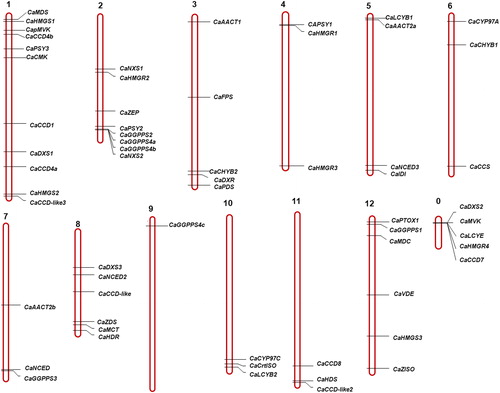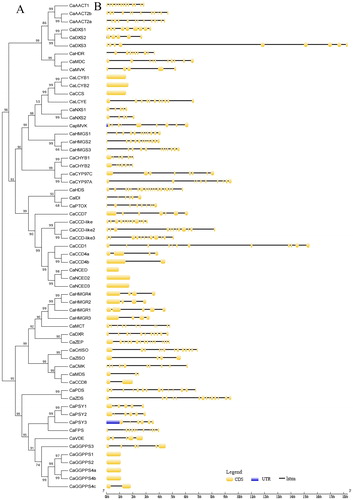Figures & data
Table 1. Carotenoid metabolic genes in pepper.
Figure 1. Chromosomal locations and duplications of the paralogous carotenoid metabolic genes on the pepper chromosomes. Note: In the figure, the chromosome numbers are shown at the top of each bar; predicted tandem-duplicated genes are indicated by thick blue lines; and gene clusters are denoted by black lines.

Figure 2. Structural analysis of the carotenoid metabolic genes: (A) NJ phylogenetic tree of carotenoid metabolic proteins; (B) Exon-intron structure of carotenoid metabolic genes. Note: In the figure, yellow indicates the exons; black indicates the introns; and blue indicates the UTR.

Figure 3. Expression heatmaps of the pepper carotenoid metabolic genes in placenta tissue (A) and pericarp tissue (B) during the fruit development stage based on the RNA-Seq data [Citation52]. Sample names were assigned as follows: placenta (PL); pericarp (PR); Stage 1, 6 DPA (1); Stage 2, 16 DPA (2); Stage 3, 25 DPA (3); mature green, 36 DPA (MG); breaker, 38 DPA (B); breaker plus 5, 43 DPA (B + 5); and breaker plus 10, 48 DPA (B + 10). Note: In the figure, the colour scale represents the relative expression levels based on log2-scaledfold changes of the RPKM during the later stages compared with those in Stage 1; Red indicates high level fold changes and green represents low level fold changes.
![Figure 3. Expression heatmaps of the pepper carotenoid metabolic genes in placenta tissue (A) and pericarp tissue (B) during the fruit development stage based on the RNA-Seq data [Citation52]. Sample names were assigned as follows: placenta (PL); pericarp (PR); Stage 1, 6 DPA (1); Stage 2, 16 DPA (2); Stage 3, 25 DPA (3); mature green, 36 DPA (MG); breaker, 38 DPA (B); breaker plus 5, 43 DPA (B + 5); and breaker plus 10, 48 DPA (B + 10). Note: In the figure, the colour scale represents the relative expression levels based on log2-scaledfold changes of the RPKM during the later stages compared with those in Stage 1; Red indicates high level fold changes and green represents low level fold changes.](/cms/asset/aa7aa9fa-502e-4fdf-9609-8749b4aa4443/tbeq_a_1824618_f0003_c.jpg)
Figure 4. Expression heatmaps of the pepper carotenoid metabolic genes following pathogen infections based on RNA-Sequence data [Citation52]. Infection by P. infestans (A), pepper mottle virus (PepMov) (B), or tobacco mosaic virus (TMV) P0 strain (C). Note: In the figure, the colour scale represents the relative expression levels based on the log2-scaled fold changes of the RPKM injections at each time point compared with the CK; Red indicates high level fold changes and green represents low level fold changes.
![Figure 4. Expression heatmaps of the pepper carotenoid metabolic genes following pathogen infections based on RNA-Sequence data [Citation52]. Infection by P. infestans (A), pepper mottle virus (PepMov) (B), or tobacco mosaic virus (TMV) P0 strain (C). Note: In the figure, the colour scale represents the relative expression levels based on the log2-scaled fold changes of the RPKM injections at each time point compared with the CK; Red indicates high level fold changes and green represents low level fold changes.](/cms/asset/4dad9eda-2d59-455f-bdbe-4dfcb13353cf/tbeq_a_1824618_f0004_c.jpg)
Figure 5. Expression heatmaps of the pepper carotenoid metabolic genes under temperature stress based on the RNA-Sequence data [Citation52]. Cold stress at 10 °C (A) and heat stress at 40 °C (B). Note: In the figure, the colour scale represents the relative expression levels based on the log2-scaledfold changes in the RPKM of the injections at each time point compared with the CK; Red indicates high level fold changes and green represents low level fold changes.
![Figure 5. Expression heatmaps of the pepper carotenoid metabolic genes under temperature stress based on the RNA-Sequence data [Citation52]. Cold stress at 10 °C (A) and heat stress at 40 °C (B). Note: In the figure, the colour scale represents the relative expression levels based on the log2-scaledfold changes in the RPKM of the injections at each time point compared with the CK; Red indicates high level fold changes and green represents low level fold changes.](/cms/asset/07f3da61-d202-4885-81a1-3c49a12c22c1/tbeq_a_1824618_f0005_c.jpg)
Figure 6. Expression heatmaps of the pepper carotenoid metabolic genes under osmotic stress based on the RNA-Seq data [Citation53]. Osmotic stress following 400 mmol/L mannitol treatment (A) and 400 mmol/L NaCl treatment (B). Note: In the figure, the colour scale represents the relative expression levels based on the log2-scaled fold changes in the RPKM of the injections at each time point compared with the CK; Red indicates high level fold changes and green represents low level fold changes.
![Figure 6. Expression heatmaps of the pepper carotenoid metabolic genes under osmotic stress based on the RNA-Seq data [Citation53]. Osmotic stress following 400 mmol/L mannitol treatment (A) and 400 mmol/L NaCl treatment (B). Note: In the figure, the colour scale represents the relative expression levels based on the log2-scaled fold changes in the RPKM of the injections at each time point compared with the CK; Red indicates high level fold changes and green represents low level fold changes.](/cms/asset/dcf98499-8c4b-4e4e-b08f-46111c998f5c/tbeq_a_1824618_f0006_c.jpg)
Supplemental Material
Download PDF (277.1 KB)Data availability statement
The data that support the findings of this study are available from the corresponding author, [HJW], upon reasonable request.
